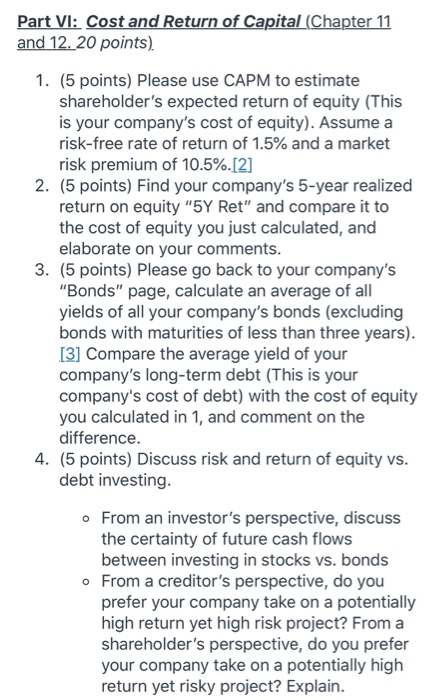Answered step by step
Verified Expert Solution
Question
1 Approved Answer
Company: Biogen Inc. (BIIB) Part VI: Cost and Return of Capital (Chapter 11 and 12. 20 points) 1. (5 points) Please use CAPM to estimate


Company: Biogen Inc. (BIIB)
Part VI: Cost and Return of Capital (Chapter 11 and 12. 20 points) 1. (5 points) Please use CAPM to estimate shareholder's expected return of equity (This is your company's cost of equity). Assume a risk-free rate of return of 1.5% and a market risk premium of 10.5%.[2] 2. (5 points) Find your company's 5-year realized return on equity "5Y Ret" and compare it to the cost of equity you just calculated, and elaborate on your comments. 3. (5 points) Please go back to your company's "Bonds" page, calculate an average of all yields of all your company's bonds (excluding bonds with maturities of less than three years). [3] Compare the average yield of your company's long-term debt (This is your company's cost of debt) with the cost of equity you calculated in 1, and comment on the difference. 4. (5 points) Discuss risk and return of equity vs. debt investing. . From an investor's perspective, discuss the certainty of future cash flows between investing in stocks vs. bonds . From a creditor's perspective, do you prefer your company take on a potentially high return yet high risk project? From a shareholder's perspective, do you prefer your company take on a potentially high return yet risky project? Explain. o Will you rather invest in your company's stocks or bonds? Or both? Why? .[1] Many websites provide financial information of public companies. For this project, you will utilize information provided by FINRA, a government authorized nonprofit organization that oversees US brokers and dealers. .[2] It is common to use historical average returns of treasury securities and the S&P 500 index to calculate CAPM. In order to make the comparisons more meaningful, I provided averages of a shorter time horizon to reflect above average performance of the US stock market during the past 10 years. .[3] This is a rough estimation since we ignore weight of value of each bond and interest rate is historically low. Part VI: Cost and Return of Capital (Chapter 11 and 12. 20 points) 1. (5 points) Please use CAPM to estimate shareholder's expected return of equity (This is your company's cost of equity). Assume a risk-free rate of return of 1.5% and a market risk premium of 10.5%.[2] 2. (5 points) Find your company's 5-year realized return on equity "5Y Ret" and compare it to the cost of equity you just calculated, and elaborate on your comments. 3. (5 points) Please go back to your company's "Bonds" page, calculate an average of all yields of all your company's bonds (excluding bonds with maturities of less than three years). [3] Compare the average yield of your company's long-term debt (This is your company's cost of debt) with the cost of equity you calculated in 1, and comment on the difference. 4. (5 points) Discuss risk and return of equity vs. debt investing. . From an investor's perspective, discuss the certainty of future cash flows between investing in stocks vs. bonds . From a creditor's perspective, do you prefer your company take on a potentially high return yet high risk project? From a shareholder's perspective, do you prefer your company take on a potentially high return yet risky project? Explain. o Will you rather invest in your company's stocks or bonds? Or both? Why? .[1] Many websites provide financial information of public companies. For this project, you will utilize information provided by FINRA, a government authorized nonprofit organization that oversees US brokers and dealers. .[2] It is common to use historical average returns of treasury securities and the S&P 500 index to calculate CAPM. In order to make the comparisons more meaningful, I provided averages of a shorter time horizon to reflect above average performance of the US stock market during the past 10 years. .[3] This is a rough estimation since we ignore weight of value of each bond and interest rate is historically low Step by Step Solution
There are 3 Steps involved in it
Step: 1

Get Instant Access to Expert-Tailored Solutions
See step-by-step solutions with expert insights and AI powered tools for academic success
Step: 2

Step: 3

Ace Your Homework with AI
Get the answers you need in no time with our AI-driven, step-by-step assistance
Get Started


